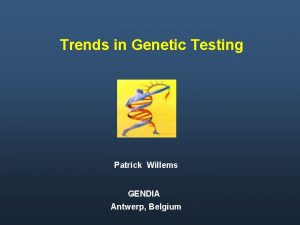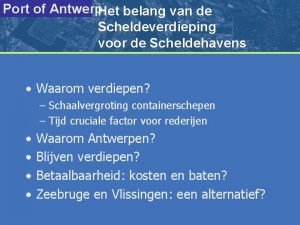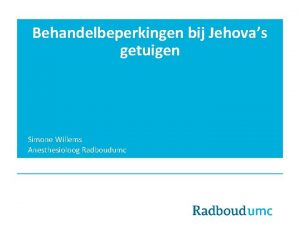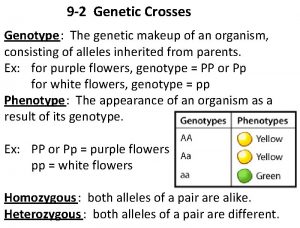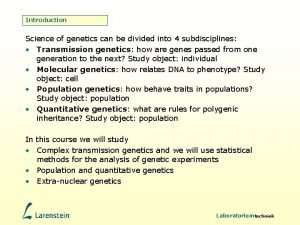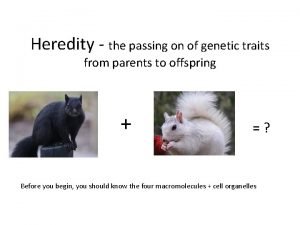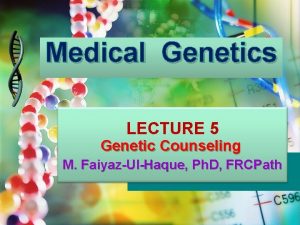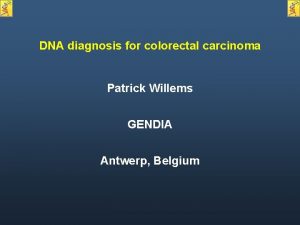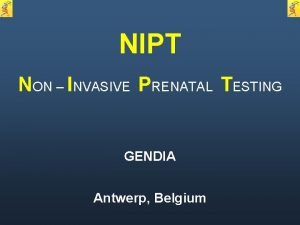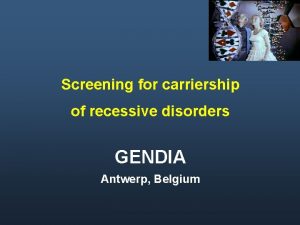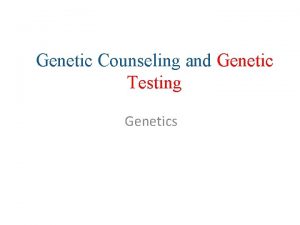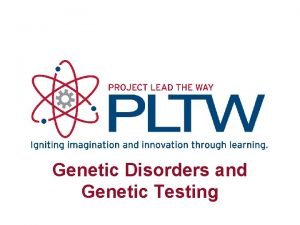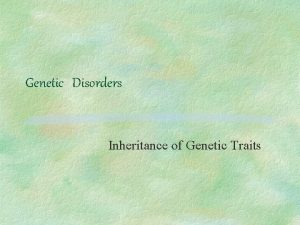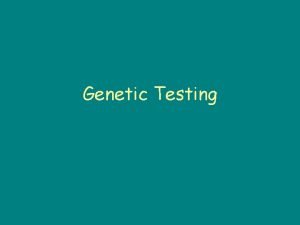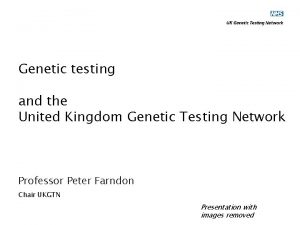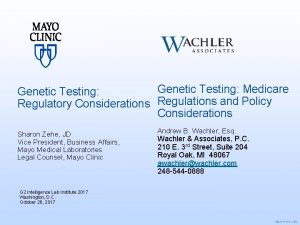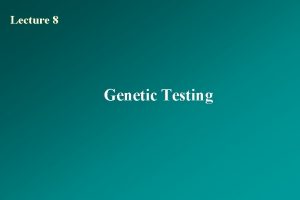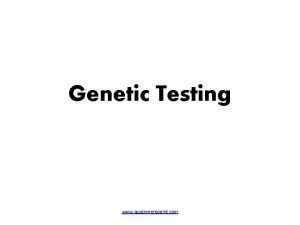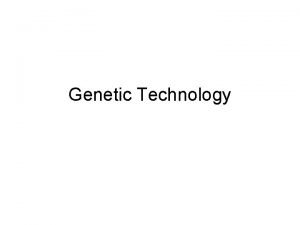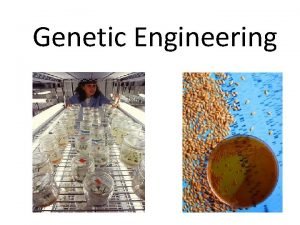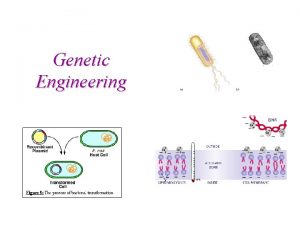Trends in Genetic Testing Patrick Willems GENDIA Antwerp









































- Slides: 41

Trends in Genetic Testing Patrick Willems GENDIA Antwerp, Belgium

Disclosure CEO and shareholder of GENDIA (private lab offering genetic tests) NO financial relationship with research bodies, medical or pharmaceutical companies, hospitals or government

Trends in Genetic Testing 1. From testing in university genetic labs to testing in private medical labs 2. From patient testing towards population screening

Current Organisation Genetic testing • Small local labs : small portfolio of tests ( < 50) • Same spectrum of tests : common + easy tests • Majority academic labs : research -diagnostic setting

Future Organisation Genetic testing From small university genetic labs to : 1. Large private genetic labs 2. Large private medical labs

Trends in Genetic Testing From small university genetic labs to : 1. Large private genetic labs • Prenatal testing : NIPT : Ariosa, Natera, Illumina, BGI Carrier testing : Counsyl • Cancer testing : Germline risk test : Color, Myriad Liquid biopsy : Pathway Genomics 2. Large private medical labs • Quest (Athena Genetics, Genzyme) • Labcorp (Correlagen) • Bioreference (Gened. X) • Sonic • Eurofins (Emory Genetics)

www. GENDIA. net

GENDIA Network 1 100 Central lab Test labs 1000 Referral labs

GENDIA network

Advantages GENDIA network • 1 lab to send samples to • 1 lab to get results from • > 3. 000 genetic tests • Large portfolio • Easy selection of first test • Best Reflex testing

Trends in Genetic Testing 1. From testing in university genetic labs to testing in private medical labs 2. From patient testing towards population screening

From patient testing towards population screening Form testing of 1 gene in 1 % of the population suspected of a genetic disorder to : 1. whole genome testing of the whole population to identify germline inherited mutations (WES/WGS) 2. Repeated screening for cancer DNA to identify somatic non-inherited mutations (liquid biopsy)

Current paradigm Patient with suspected genetic disorder visit Pediatrician-neurologist-gynecologist visit Geneticist Genetic test

Future paradigm Healthy individual visit Dr. Google Physician Genetic screening test visit Physician Geneticist Dr. Google

New genetic tests 1. GERMLINE MUTATIONS • NIPT • STID • CANCER RISK • WES / WGS 2. SOMATIC MUTATIONS IN CANCER • CT-DNA (liquid biopsy)

NIPT NON – INVASIVE PRENATAL TESTING Prenatal testing of cff DNA (cell free fetal DNA) from maternal blood for trisomy 21 (Down syndrome), Trisomy 18, trisomy 13, and fetal sex NIPT is worldwide the most frequent genetic test with > 1 million tests per year (GENDIA : > 33. 000 NIPT)

NIPT cff DNA • <<< 1 % of total DNA in maternal circulation is fetal • 5 - 40 % of cell-free DNA (cf DNA) in maternal circulation is fetal

NIPT currently is most common genetic test More NIPTs than all other genetic tests together Approximately 1 million NIPTs per year worldwide Future Market value : 4 billion US / year (price : 250 – 500 Euro per test)

STID SCREENING TEST for INHERITED DISEASE Testing of future parents for common recessive diseases such as cystic fibrosis, thalassemia, fragile X, SMA (overall frequency : 1/200) before or during pregnancy CARRIER SCREENING is worldwide the second most frequent genetic test If both parents carry a mutation in the same gene the risk of an affected fetus is 25 % and prenatal testing by CVS or AC is offered

STID Disorder Gene Frequency Cystic Fibrosis Spinal muscular atrophy Deafness Fragile X Thalassemia CFTR SMN 1 GJB 2 FMR 1 HBB 1/3000 1/5000 1/2000 1/5000 1/3000 (1/300) Many metabolic disorders many genes 1/200

Genetic screening in Askhenazi jews

New genetic tests 1. GERMLINE MUTATIONS • NIPT • STID • CANCER RISK • WES / WGS 2. SOMATIC MUTATIONS IN CANCER • CT-DNA (liquid biopsy)

CANCER RISK TESTING The cancer risk test identifies patients with a germline mutation that have a high risk to develop cancer

Cancer tests Minority of cancers is inherited due to germline mutations CANCER RISK TEST Majority of cancers is not inherited and due to somatic mutations in the tumor LIQUID BIOPSY

Inherited Cancer due to Germline mutations • Ovarian Cancer : 15 % • Breast Cancer : 10 % • Colon cancer : 5% • Prostate cancer : low • Lung cancer : very low

Cancer risk test Analysis of 30 cancer genes : BRCA 1, BRCA 2, APC, ATM, BAP 1, BARD 1, BMPR 1 A, BRIP 1, CDH 1, CDKN 2 A CDK 4, CHEK 2, Ep. CAM, GREM 1, MITF, MLH 1, MSH 2, MSH 6, MUTYH, NBN, PALB 2, PMS 2, POLD 1, POLE, PTEN, RAD 51 C, RAD 51 D, SMAD 4, STK 11 and TP 53 Involved in genetic predisposition to + Breast and Ovarian cancer, + Intestinal and uterine, + Pancreas, stomach, skin and prostate cancer Most likely third common test worldwide Price : 359 Euro (10 Euro per gene)

CANCER RISK test GENE Breast Ovaria Uterus Colon BRCA 1 ● ● TP 53 ● ● BRCA 2 ● ● PTEN ● ● ● MLH 1 ● ● ● STK 11 ● ● CDH 1 ● MLH 2 ● ● ● BMPR 1 A ● MSH 6 ● ● ● SMAD 4 ● PMS 2 ● ● ● GREM 1 ● EPCAM ● ● ● POLD 1 ● APC ● POLE ● PALB 2 ● ● MUTYH ● CHEK 2 ● ● MITF ATM ● BAP 1 NBN ● CDKN 2 A BARD 1 ● ● CDK 4 BRIP 1 ● ● RAD 51 C ● TP 53 ● ● RAD 51 D ●

WES / WGS WES (Whole Exome Sequencing) WGS (Whole Genome Sequencing) To identify the genetic cause of a presumed genetic anomaly

DNA Sequencing 1980 -1990 1990 -2005 > 2005 Radio - gel Fluorescent - capillary Next generation Thousand bp / day Million bp / day Billion bp / day

Finding the one pathogenic variant that is the needle in the hay stack

The power of WES CASE 1 : Recurrent attacks of metabolic acidosis, psychomotor retardation and microcephaly. Her metabolic profile was normal. Diagnosis unknown. A pathogenic homozygous WDR 73: c. 287 G>A variant was identified in exon 4 of the WDR 73 gene. Mutations in this gene lead to Galloway-Mowat syndrome. In > 70 % of cases with presumed monogenic disease the disease gene and mutation are identified by WES. Price : 1500 Euro

WES / WGS 1. To identify the genetic cause of a congenital anomaly eci 2. To identify carriership for recessive disorders (expanded STID) 3. To identify monogenic mutations causing adult-onset disease – Neurological disease – Cardiovascular disease – Cancer 4. To identify risk factors for multifactorial disease

Trends in Genetic Testing Patrick Willems GENDIA Antwerp, Belgium

New genetic tests 1. GERMLINE MUTATIONS • NIPT • STID • CANCER RISK • WES / WGS 2. SOMATIC MUTATIONS IN CANCER • CT-DNA

CT DNA testing CIRCULATING TUMOR DNA testing screens for somatic mutations in cell-free DNA (cf DNA) from cancer cells in blood

CT DNA test : screening for germline mutations • CT DNA test screens Cell-free DNA from the cancer cells in blood (liquid biopsy) • DNA from cancer cells contains patient-specific oncogenic mutations • Cancer therapy is dependent upon the specific mutation (Personalised medicine) • Liquid biopsies are therefore “thera-diagnostic” tests • Estimated market of liquid biopsies : 40 billion USD per year

Targeted treatment for cancer Personalised targeted treatment inhibits specific mutations that cause cancer These mutations are patient-specific Mutations can be detected by molecular studies of : . tumor material (biopsy) : FFPE, fresh or frozen. blood (liquid biopsy) Therapy is dependent upon the specific mutation Personalised medicine

Advantages liquid biopsies • No tissue biopsy needed • No FFPE fixation • Profiling the overall genotype of cancer • primary cancer • circulating cells • metastases • Better evaluation of : • reaction to therapy • development of resistance • Also screening of patients without tumor but high cancer risk

Current indications for liquid biopsy • Follow up of patients with cancer as a follow up of treatment • Screening of individuals at high risk for cancer (BRCA, HNPCC carriers)

Future indications for liquid biopsy Every adult every year as a general cancer screening

Looking into the future NIPT WGS CT-DNA
 Gendia
Gendia Antwerp
Antwerp Iccg antwerp
Iccg antwerp Dries meerts
Dries meerts Port of antwerp
Port of antwerp Cgg vagga
Cgg vagga Founders effect
Founders effect Genetic drift vs genetic flow
Genetic drift vs genetic flow Genetic programming vs genetic algorithm
Genetic programming vs genetic algorithm Genetic programming vs genetic algorithm
Genetic programming vs genetic algorithm Genetic drift
Genetic drift Matthieu willems
Matthieu willems Hochetus
Hochetus Simone willems
Simone willems Decision table testing in software testing
Decision table testing in software testing Data flow testing strategies in software testing
Data flow testing strategies in software testing Extended entry decision table
Extended entry decision table Component testing is a black box testing
Component testing is a black box testing Functional testing vs unit testing
Functional testing vs unit testing Decision table testing examples
Decision table testing examples What is domain test
What is domain test Positive vs negative testing
Positive vs negative testing Rigorous testing in software testing
Rigorous testing in software testing Types of domain testing
Types of domain testing Cause effect graph for triangle problem
Cause effect graph for triangle problem Error yang dapat diketahui dari pengujian black box adalah
Error yang dapat diketahui dari pengujian black box adalah Cs 3250
Cs 3250 Testing blindness in software testing
Testing blindness in software testing Control structure testing in software testing
Control structure testing in software testing Kv charts in software testing
Kv charts in software testing Behavioral testing adalah
Behavioral testing adalah Localization globalization testing
Localization globalization testing Section 9-2 review genetic crosses
Section 9-2 review genetic crosses Introduction to genetic analysis tenth edition
Introduction to genetic analysis tenth edition Genetic toggle switch
Genetic toggle switch Genetics
Genetics Is aspergers genetic
Is aspergers genetic Gene terminology
Gene terminology Traits
Traits Genetic drift in small populations
Genetic drift in small populations Genetic counseling definition
Genetic counseling definition Genetic engineering
Genetic engineering
